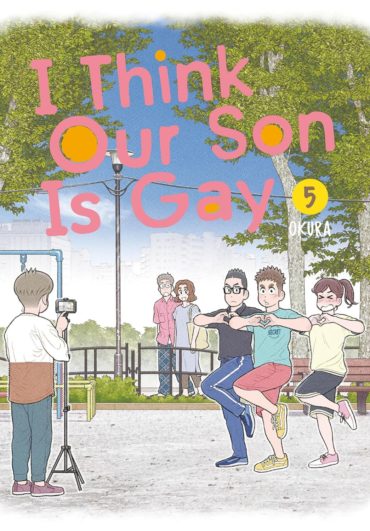I Think Our Son is Gay Volume 5 Review
The Aoyama family: doting mother Tomoko, exuberant high-schooler Hiroki and his quiet, self-contained younger brother Yuri are going back to being a family of four again as absent father Akiyoshi (who’s been away on a work assignment abroad) is returning home for good. And Akiyoshi is one of those people who tends to speak his thoughts aloud without much regard of their impact on anyone else. Tomoko has suspected for a long while that their eldest Hiroki is gay but has been content to see how things go, encouraging him with his high school activities and his various enthusiasms. She’s watched over him as his best friend (and secret crush) Daigo has got himself a girlfriend and he’s tried to hide his feelings by throwing himself into his school clubs (even though he’s never once openly admitted that he might have felt more than friendship for Daigo).
And then there’s Hiroki’s childhood friend Asumi (also in the choir) who’s liked him for a long time. When Asumi admits her feelings to Hiroki, he doesn’t know how to let her down gently, yet still continue their friendship. The fact that he’s able to discuss this with Tomoko (in a detached kind of a way!) and Yuri means that what could have been a traumatic experience all round is sensitively managed and Asumi, Daigo and Hiroki stay friends.
Having Akiyoshi back at home all the time is something of a mixed blessing for the rest of the family because he tends to open his mouth before engaging his brain. When he spots a celebrity on TV who’s become more open about his sexuality, Akiyoshi blurts out, “But really, what is it about fairies? What makes these guys wanna turn into them anyway?” which causes both sons to leave the room and Tomoko remind her husband about her openly gay coworker and say, “Maybe you shouldn’t go around saying careless, mocking things like that.” Akiyoshi, non-plussed, replies, “It’s just like a total mystery to me, you know. Is it so wrong to ask questions?” And Tomoko realizes that it’s not going to be easy encouraging Akiyoshi to develop a more open mind and to become more aware of what he says around Hiroki. Then, when they’re out shopping, who should they bump into but Mr. Tono, her colleague, and his male partner. After some bonding over an interest in cooking utensils, Tomoko hopes all is going well – but after Akiyoshi goes to the men’s cloakroom, he comes out highly flustered. Later, he admits to Tomoko that he said something horrendously insensitive to Mr. Tono’s partner about being gay. Is he ever going to be able to change his ideas? And how will father-son relations work out if Hiroki really is gay and his father is having such a struggle to come to terms with LGBT+ issues?
There’s been quite a large gap between Volume 4 (October 2022) and the eventual arrival in English from Square Enix Manga of the final volume in OKURA’s well-liked LGBTQIA+ series. I was wondering quite how the mangaka would bring the story of Tomoko and her (probably) gay elder son Hiroki to a close and it’s fair to say that this is a well-thought-out resolution. Issues, personified by dad Akiyoshi thoughtlessly using terms such as ‘fairy’ and ‘screaming gay’ – as well as some less than sensitive issues amongst Tomoko’s female fellow workers – are gradually worked through. The (very) short chapter format suits what OKURA wants to highlight really well and the chapter titles ‘What is “Normal”?’ ‘What If Our Son Is?’ reinforce his subject matter which is summed up in the Afterword: ‘It’s the common belief that being gay is something to hide… and this idea is so ingrained in most of us… that it made me want to write this story.’ This volume also touches on another aspect of the LGBTQIA+ spectrum: Ace/Asexual.
As before, though, this is a story about Hiroki (and his friends) told from an adult point of view. In the final volume it’s not just Tomoko’s viewpoint, we also get plenty of moments in which we either cringe at the way Akiyoshi is reacting or we come to sympathize with his predicament as he realizes that attitudes are changing in society and he will have to examine his prejudices and assumptions if he wants to be a good dad to his sons. So, I’m a little curious (as before) as to whether, given the Teen rating, the target audience is really the same age as Hiroki and friends – or their parents.
OKURA’s cartoonish graphic style works well when presenting some quite pointed observations about the often-insensitive way people still treat those who identify as gay. There are lots of little moments which, while depicted with humour, make an impression on the reader and they’re usually because of the comments people make without thinking about their impact, whether it’s one of Tomoko’s female colleagues unthinkingly criticising her approach to parenting or husband Akiyoshi blurting something out.
The excellent translation for Square Enix Manga is again by Leighann Harvey with lettering by Lor Prescott. It’s a pity, though, that there are no translation notes for this series as there are several Japanese media and cultural references that it would be interesting to have explained – but their absence won’t affect your enjoyment of reading the volume. There’s a colour illustration at the beginning as well and the mangaka’s self-deprecating Afterword is fully illustrated in his own unique style.
It’s good to see this likable and approachable LGBTQIA+ series come to an upbeat and forward-looking conclusion without outstaying its welcome. Recommended.
Our review copy from Square Enix Manga was supplied by Turnaround Comics (Turnaround Publisher Services).


